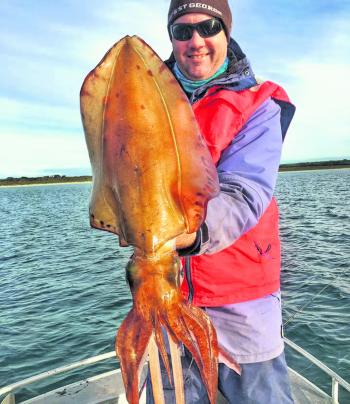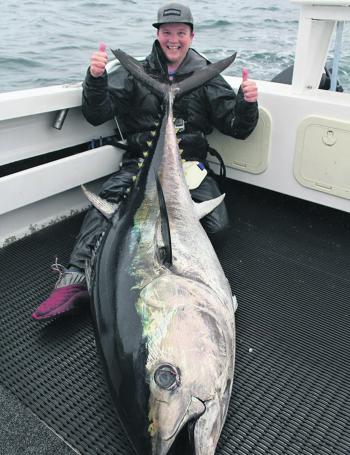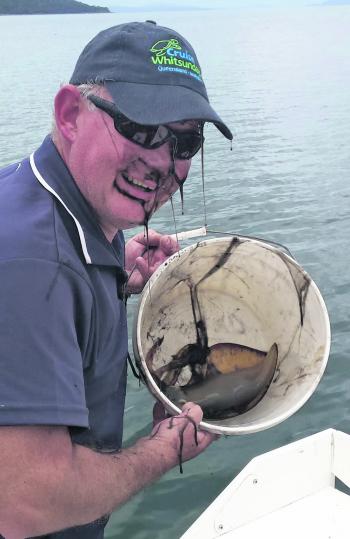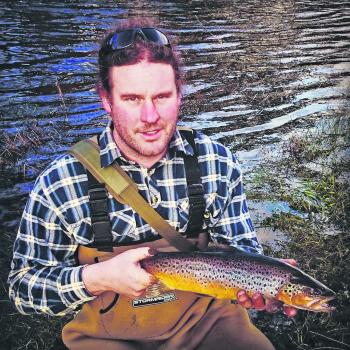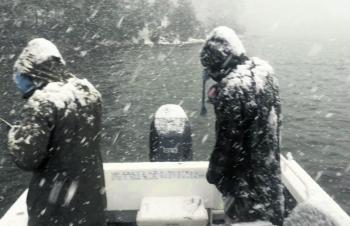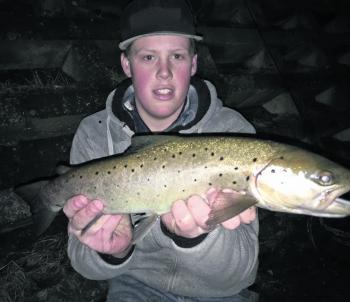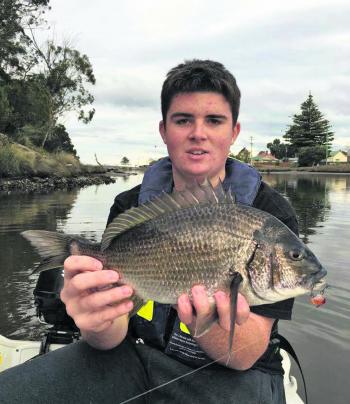September in Tasmania is a like a Wednesday in the working week. You’re over the hill, and it’s all cruising to the weekend. We maintained the passion for fishing through winter wild weather. We’ve battled snow, wind and rain. We reached the top, and fishing is what’s left to enjoy as we head into summer months.
The big excitement has been trout fishing. This is set to continue into September and beyond. Record rains have filled water storages and natural dams. Fish reacted by feeding heartily. Rivers have been up and the banks have supplied heaps of food into the waterways. Fish are in great condition.
The settling conditions in September will allow the squid to move in and become thicker. The incredible amount of fresh water headed to sea and the sediment has slowed down the squid recently. Look for that to change dramatically as the water clears up. I get a little excited as September arrives – the daylight hours stretch out, and we’re only a month away from daylight savings. I love a few extra daylight hours to jam in extra fishing. Let’s look at what’s on offer around Tas.
Low Head is the gateway to some sensational squid fishing in September. The big calamari will be keen to come in and lay their eggs along the rocky coastline of the North East. They amass great numbers and are great, tasty fun. Weymouth and Bridport as you head east are other areas with lots of big squid.
Remember, a good quality jig will work the bottom third of the water column and help you locate squid. Once you’ve worked a few off the bottom, they’ll come to you. If you catch one on a nice rod, work it up and leave it under the boat – other squid will come up looking to feed. Turning a few over nice and quick, and catching your bag limit becomes easy. Soft supple tipped rods really work for me with squid fishing. You can use just about any rod, but you’ll have more hook-ups and retain more squid with a soft tipped rod. Given the lack of barbs on a squid jig the hook set and constant load that is easy to apply through a soft action rod is much preferred.
Once you’ve got your fill of squid, around the rocky points of Bridport, use the squid tentacles as bait. You should be able to entice flathead to your rig with some fresh squid tenty. If you can get a nice little drift going, around the gutters towards Ninth Island, you’ll be in great form. When the weather is still and calm, drop the anchor and start a berley trail. Get the berley bucket to the sea floor with some weight in the bottom. Give it time to work, and you may come across bigger flatties, and the odd gummy shark.
Ansons Bay is an area people tend to forget, tucked away in the northeast corner of Tasmania. If you’re looking for a place to explore as the days grow long and the sun stays out, keep it in mind. The bay is fishable on the shore, but the real delights are found in a small boat. The fishing will slowly pick up in September. Explore the area while it’s quiet. A quiet prospect mission with few soft plastics may end up with you landing a trophy southern black bream.
The Forth River was a wonder to me growing up. It was a powerful stretch of water with signs at the weir and river mouth, detailing how many had drowned. The river was to be taken seriously while we played and fished its length.
In early years, we’d fish the spring days of September with light mono and an unweighted worm in a back eddy. The bigger, juicier wiggly worms were better. The bail arm would be left tripped and the rod placed in a crafted branch pressed into the bank. I watched rod tips for hours, waiting for the bounce.
The Forth River has plenty of great spots to drown a worm or flick a soft plastic. The stretch of river that fills on the incoming tide along Leith Road is one. Access this shore from the elevated road. It’s quite steep, so be careful. Once you’re in position, you’ll see an open rocky shore. It’s shallow towards the highway road bridge, and deepens as you head upriver. Take a look at the deep hole where the main river splits into a rivulet along the road edge. Further up the river, as the water flow starts slowing, check out Pump Station and Wilmot roads.
The water will slow down later in September. The East Coast and southern rivers get all the attention as bream fisheries in Tasmania. I’ve always thought the upper reaches of the Forth River estuary were very ‘breamy’. I managed to snare a good one that went 45cm to the fork on a hardbody lure. It was a three day effort, trying to get the tide right over a rocky section I liked. I caught plenty of tiny tailor and nice Australian salmon, but no bream. A few long, low casts for nothing – I started talking to myself. Fishing slower, long casts with rod twitches and winds to work the little bibbed minnow down, I hooked up.
Keep in mind, as the weather gets better, try the Leven, Forth and Mersey rivers for some bream. It takes effort, but let’s see if we can develop a bream fishery on the North West Coast! The Mersey River has been decimated by the floodwaters of June. The banks and river bottom has been gouged out, and trees lining the bank have been torn out and spread. This river will be new to all that fish it this season. To many who knew spots and river flows like the back of their hand, it’s a grave shame, but it’s also an opportunity to learn and explore.
Rivers in severe flood never really fish that well, as the water moves too fast. The fish sense this event may leave them trapped when the water recedes just as swiftly. September will bring a settled river with the occasional water rise from spring rain. This slow water incursion up the banks will have the fish feeding and active. Great days are ahead, getting to know the Mersey River again as it reshapes into one of the state’s premier waterways.
Flyfishers won’t lament the trees that were swept down river out to sea. New areas have opened up and a whole heap of back cast snags are gone. The flyfishing in the Mersey River in September is traditionally very good. It will be interesting to see how changes in bank and river bottom affect fishing in the upper reaches.
The Mersey and Forth have good runs of whitebait. The sea run trout fishery is well-regarded. Leave early and stand on the edges, where the river flow is reduced. If you look carefully, you may be able to make out the translucent and grey shapes of little whitebait in their annual migration. Trout love these and gorge on them. When the conditions are right, trout launch at them and send bait fleeing in all directions. The mouth of the Forth River and along banks to the train line are perfect to see this.
Get a good natural representation of whitebait and keep them high near the surface. Flies fished under bubble floats, or with tiny split shots attached work. Fish your lures with light jigheads and main line so you can get a nice long cast.
Sea trout can be found chasing whitebait along the rivers flowing into Bass Strait, such as the Leven at Ulverstone, Blyth at Heybridge, Emu at Wivenhoe and the Inglis at Wynyard. These are all worth a look from time to time throughout September.
The record rain we had over July and August have got everyone’s minds on how the lakes will fish. August was promising and many areas fished well. Taking opportunities when the weather allowed was the cornerstone. The weather will calm in September and the swollen edges of lakes and rising water levels are exciting. Lakes in the west had spilled hard in early August. This is amazing, given their levels at summer’s end. Insects and grubs were taken by surprise and eaten by inhabiting trout. This will put good condition on fish, and make for some very nice catches.
The Great Lake, Arthurs and Echo are hydro lakes and have been low. The wet winter has anglers excited. If the water continues to flow into the lake and outweigh water taken for power generation, we’ll have an awesome slow water rise event. The trout will recognise rising levels and follow it up, feeding on grubs and worms that are drowned out. Previous dry areas will be a treasure trove of bugs, beetles and insects, high on the trout menu. If you find a marshy section with the water level rising, you’ve found gold.
In these wetter marsh areas, there can be all manner of marine life that has flourished without predatory fish. With water covering these areas again, bigger fish will be keen to feed. It’s a flyfisher’s paradise. Learners can sample the joys of fly casting. In high school, I liked to fish a wet fly in the weedy ground at Haddens Bay. It was only when a finger of water would head up the middle and mushroom around the weeds that I could entice fish to the fly.
These are big hydro lakes, but there are smaller lakes that fish well too. Little Pine and Pine Tier Lagoons, and Augusta and Fergus lakes can see their levels rise quickly in the right conditions. These conditions are intrinsically linked with rain, so take a good coat and hat.
Knowing these conditions and how they turn fish on and start a hot bite comes with experience. If you don’t nail it first time, don’t worry. It’s very much a case of honing your craft. Keep a notebook and persevere. The way trout switch on in a weather event and feed on a food source that is also reacting is mystical. It can shut down as quick as it started.
A few hours may be all you get. Be organised and have what you need on you. If you wonder why a flyfisher looks like an operative about to go commando, you must be self-sufficient while knee deep in a lake. Ain’t nobody got time for heading back to the car.
Gear doesn’t need to break the bank. Like all sports and pastimes, spend what you can afford and concentrate on technique more than bling. You’ll have good success. This applies to all forms of casting. Don’t rush out and buy the rod and reel for flycasting that costs eleventy squillion dollars.
The best thing you can ever do, when starting flyfishing, is to have instruction. If that is from a mate who seems to be quite good at it, fair enough, but the best instruction comes from a certified flyfishing teacher. Yep, there’s a system of certification in Tasmania, and we have excellent teachers. The time and money spent on instruction will be worth it and will save you money later. Rush out, buy a heap of gear and try to self-learn – that gear will be heaped in a pile of frustration and disappointment. The similarities to golf are amusing – you’ll never develop a good swing trying to belt the cover off the ball every time.
Flyfishing is not about double hauling line out. Be quiet and stalk your game in the rising waters. You may have a decent fish swim between your legs. You will need a rod from 2-7wt. If you’re likely to fish in wind, which is often, use a rod with a higher weighted line.
The water will be shallow on the flooded banks and shores, so a weight forward floating line is fine. Most of your fishing will be done in close, so the weight forward nature of the line will help load the rod with a short amount of line out. Over weighting the rod and using a line weight one or two up from the rod specification will allow you to load the rod up with little line out. There are so many leader options and flies for the area you wish to fish. Your local tackle store’s the best place to chat about these.
Early season is often when wet flies come out to play, as most of the flooded out food sources are under the surface. I’ve noticed a real following develop for rabbit fur flies. A fly tied to look like the humble earthworm will slay them, so head out and give that a try. Even the green as grass beginner can manage to flop that out with a fly rod.
Rug up and get some gloves. The weather’s still fresh.
It’s the start of spring. River systems of the East Coast have had water pour through them and out to sea. Some may see the long rains as a bad thing, but the flush is fantastic for systems like the Scamander River mouth and Georges Bay. These estuaries are the lifeblood of fishing in the area. To have them healthy and revitalised is great. Of course, with all the flow, food is dispersed into the water and channels. This brings Georges Bay alive, where big salmon schools flourish and trevally and garfish prosper.
Silver trevally are fun to catch and not too bad on the chew either. They like a bit of structure and water flow. Broken bottom or a rocky out crops leading to deeper water are awesome for silver trevally. They feed hard on anything from small fish to crustaceans or prawns. Soft plastics are a favoured way to take trevally and Berkley has a few they find irresistible. Turtle Back Worms in pumpkinseed and watermelon are standouts. Fish these on jigheads to suit the current.
Fish a little heavy – have the baits flutter down and sit hard on the bottom. Trevally like to hit it on the drop or while it settles on the sea floor. Move your plastic slowly with little drags and hops. With a modern fast action rod and braid, it’s amazing how little rod tip action you need to bring plastic alive. On a jetty with clear water, if you can see the bottom at your feet, have a practice. Flick your plastic into the water and play puppeteer. Remember the action you put on the rod while maintaining a good connection. Copy that when you cast into deeper water. You should have a bite in no time.
Bream are still dormant due to the colder water temperatures. The water has yet to start to warm up and the fish are in the deeper pools. Look for them in deep holes in the Scamander and Swan rivers and fish slow on the bottom. Sinking vibes are a good way to find fish and wake them up. Cast long to the back of a deep pool and let your vibe sink to the bottom. Give the rod a few high lifts and then leave it on the bottom. A few small rattles and a long pause should see action if the fish are about. You could also use a mid-weighted grub. Fish it very slow with plenty of little rattles and pauses.
When traversing rivers like the upper reaches of the Swan, travel slowly. Learn the drop offs and rock bars. Slow down on a sunny day, and you’ll get a very good idea of where the deep pools are. Good quality polaroid glasses make it easier. Put this detail to memory, or make notes. Having an idea where these are will allow you to pull up a good cast before them. Sneak up on the fish-holding pools and lob a cast before the boat is near. This will raise your chance of catching nice big bream. Remember to work the bottom slowly.
The Swan River has sensational bottom that will take plenty of exploring. Exploring can be as enjoyable as the fishing. This time of year, bream are great eating. The cooler water may make their flesh firmer or the winter temperatures could have put on some condition. Who knew? A piece of crispy skin bream with a drizzle of lemon and some pepper is yum.
Bicheno comes alive in spring, so don’t forget this sleepy seaside town. The squid fishing will improve, as clefts and underwater geography are good for squid egg laying. The cephalopods are big in these parts – fishing for them in deep water can surprise anglers. The go-to spot for a feed of squid is the sheltered waters of the local anchorage in Waubs Bay. The east end of the beach breaks away to rocky ground. That area’s a great spot to get squid and can be accessed and fished well by boat or land-based. Don’t despair if you have no boat. The Blowhole is the same, but always be careful when fishing from the rocks.
Stout footwear is a must, with a healthy respect for the ocean’s power. If weather is kind, Bicheno’s good for a drift. Look for flathead, they’re in close and move about into deeper water. A couple of drifts and you should come onto them. Don’t be scared to move out 10m depth increments at a time. You’ll find them with well presented soft plastics.
Soft plastics need some action in the tail. Last year a couple bass spinnerbaits from Geecrack on my son’s rod really appealed to the flatties. It out fished our other offerings ten to the dozen. My five-year-old son came away beaming and we named him Flathead King for the weekend. A memory for life was created.
Bicheno and coastal areas to the north and south are flathead hotspots. Tiger flathead feature well off the deeper areas around Schouten Island, all the way down to Maria Island. They move in at this time of year to spawn and can be found in closer than normal. I tend to look for them in 50m of water, and continue right out to the edge of the shelf.
Tiger flathead have an elongated body with a large flattened head. They’re light brown with a heap of splotchy dots with a white belly. These spots can be light brown to orange on the upper body and sometimes grey. They have nasty spines waiting to nail the unwary and over bold. They’re found on the dorsal fins and tucked away. Take care when handling around the gill flaps, as the two spines on the side of their head will make you bleed.
Given the depth these are found in, bait fishing is common for them. Bag limit for these tasty critters is 20. Note this is a combined limit with sand flathead. You’ll have some explaining to do if you come in with 20 of each. Finding a patch of tigers, you very rarely throw any back. The size limit is 32cm, and often they’re closer to 50-60cm.
Looking to fire up in September – sea runners – these powerful silver footballs create their own hype in the Derwent River. Everyone loves to be king of sea runners. Anglers throw bait and lures at them with gusto. All success is posted on Facebook with great pride. The favourite spots are guarded, spoken about in hushed tones. Backgrounds are smudged out in pics.
Trout fishing is so easily accessible in Tasmania and we take it for granted. Our wonderful fishery and areas surrounding our capital city should be treated like treasure. The fishing we experience around the CBD is world class. Half an hour out, it gets better and an hour after that is better again.
The action started in August and looks to really firm this month. The sea going versions of Salmo trutta will be pouring into the Derwent, and rivers around the Huon for whitebait. Whitebait is the collective term for several species of native baitfish. These tiny fish head up the brackish waters of our systems to spawn and die. It brings some of the coolest brown trout fishing you’ll experience.
A sea-run trout is a brown that’s made a significant life decision to head out to sea. This is where they develop their significant silver look and powerful physique. These fish are often in much better condition than brown trout. Rather than eating stick cadis and beetles, the life of a sea runner is spent chasing and eating coastal baitfish.
There are many ways to catch these silver torpedos, so practice and find your favourite. Whitebait are often pushed up into shallows. Flyfishers have some advantage in fishing light and this is wet fly domain. Fish an 8-9ft rod weighted from 6-8 wt line.
I have fished for sea runners blind, casting to a likely spot in the hope there may be a sea runner lurking. The fun of flyfishing is when you find a fish or two charging bait up. You will need a weight forward taper or double taper fly line with a tippet from 4-10lb. Lean towards the heavier tippet, as sea runners are found shallow around some nasty bottom.
Bait fishing for sea runners at night is popular around the state, but in the south it’s a specialist art. You can fish bait static, but the more common method is to slowly retrieve a dead minnow back through the darkness. Dark brings out the big fish and is always a great weapon. Trout are timid by nature, but darkness makes them bolder. It draws them out of deeper channels. Fishing a dead minnow on the Bridgewater Drag rig is a deadly way to bring a sea runner in. This rig consists of two small trebles. The bigger one, around size 10, is snelled to the line with a little tail. The second ties on with an improved cinch knot. The big treble has one hook leg in the head and the rear hook a single leg in the tail. Now cast your dead minnow out into the darkness and slowly retrieve.
Browns River has been turning it on for bream fishers down south. It’s a popular spot for bait fishing and hardbody bream fishing. The go-to lures are suspending minnows. Lures like the Hurricane bent minnow and Cranka Crab are performing well. Steve Steer has developed the Cranka Crab, a Tasmanian business that everyone can support.
1
Shaun House with a very nice southern calamari.
2
Spring’s quality fish have the author excited.
3
Harry Murfet with a Mersey River fish. The flooding has changed the river extensively.
4
Glen Saltmarsh and Jason Sims are hardcore.
5
Sweet fish are out there to grab on nice tackle.
6
The author loves a good session on tiger flathead. Longer days mean more fishing.
7
Jack Guard has been cracking onto silver torpedos in the Derwent River.
8
Jared Flakemore with a beaut trout from the Huon area.
9
Callum Lord with a nice bream in Browns River.
10
Damian Turner got this big barrel on his birthday, what a riot!
11
Watch out for those slippery squid!
Reads: 5513